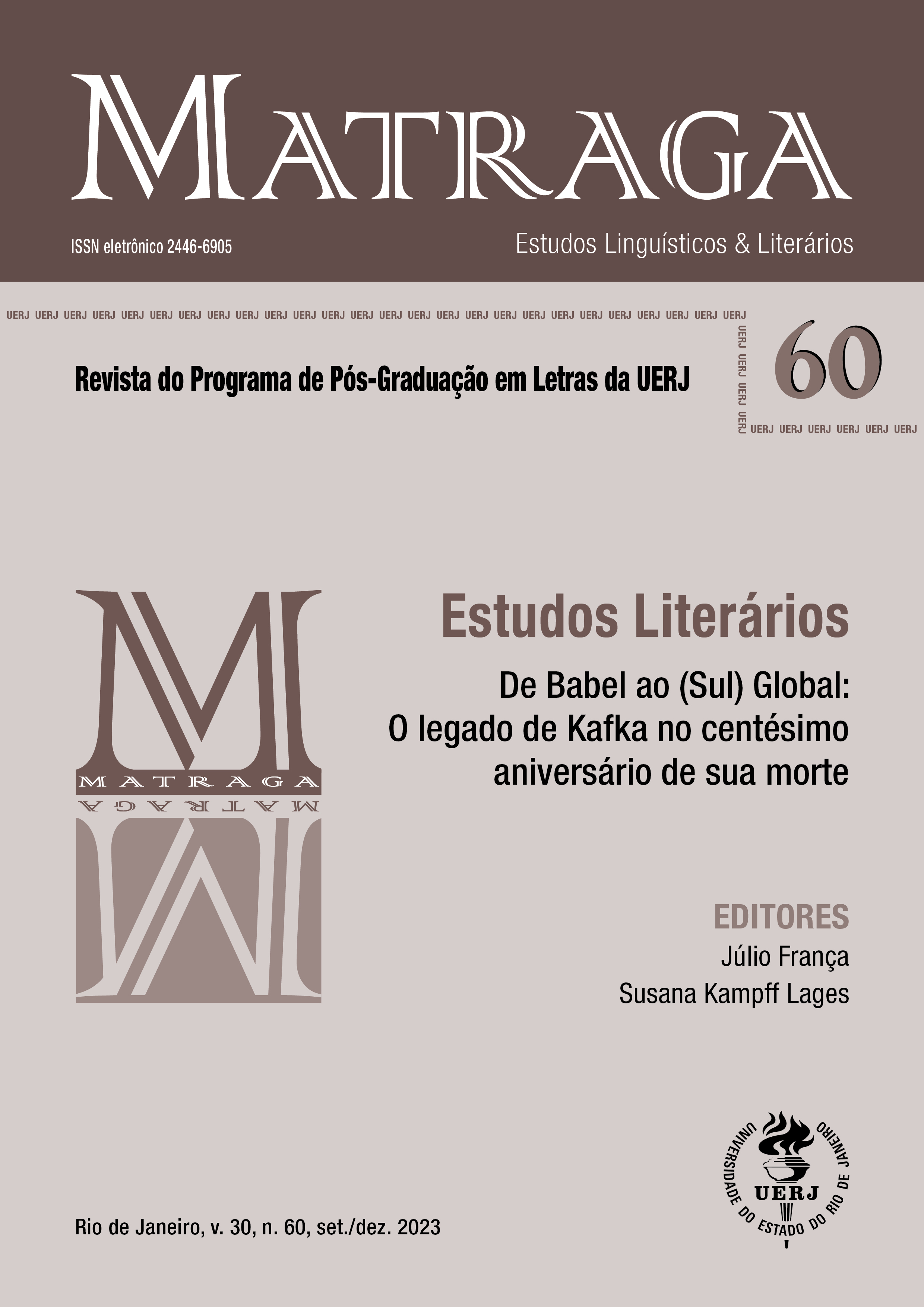A presença de Kafka no romance contemporâneo: Sefarad (2001) de Antonio Muñoz Molina
DOI:
https://doi.org/10.12957/matraga.2023.73077Palavras-chave:
Romance contemporâneo, Intertextualidade, Kafka, Muñoz Molina, SefaradResumo
A presença de grandes romancistas da alta modernidade e seus clássicos é uma tendência observada na feitura dos romances contemporâneos (Perrone-Moisés, 2016). Por vezes, esses escritores são tornados personagens de ficção, por outras, são feitas releituras de suas histórias e personagens icônicos. Uma das formas pelas quais se revela essa presença é por meio do uso reiterado de procedimentos narrativos de intertextualidade, tais como transposições, imitação, citações, alusões e referências (Genette, 2010) (Samoyault, 2008). Em toda sua narrativa de ficção, o escritor espanhol Antonio Muñoz Molina (1956) apresenta essa tendência. O romance Sefarad (2001) é um dos que melhor exemplifica essa escrita literária inspirada por releitura(s), e o escritor moderno, cuja onipresença é latente na escrita desse romance, é Franz Kafka. Este artigo tem como principal objetivo analisar os procedimentos de intertextualidade empregados por Muñoz Molina na composição de Sefarad, a fim de sistematizar a presença de Kafka na feitura do romance, atribuindo sentidos possíveis a essa presença. O resultado do estudo revela que Kafka figura na composição de Sefarad de três formas: transformado em personagem de ficção; por meio da intertextualidade estabelecida com alguns de seus mais emblemáticos textos; e pela capacidade visionária atribuída pelo escritor contemporâneo à Kafka como privilegiado pensador de seu tempo.
Downloads
Referências
AMÉRY, Jean. Além do crime e castigo: tentativas de superação. Tradução Marijane Lisboa. Rio de Janeiro: Contraponto, 2013.
BUBER-NEUMANN, Margarete. Milena. Tradução Tati de Moraes. Rio de Janeiro: Guanabara, 1987.
GENETTE, Gérard. Palimpsestos: a literatura de segunda mão. Extratos traduzidos por Cibele Braga et. al. Belo Horizonte: Viva Voz, 2010.
KAFKA, Franz. A metamorfose. Tradução Marcelo Backes. Porto Alegre: L&PM, 2016.
KAFKA, Franz. Cartas a Milena. Caracas: Fundación Editorial el perro y la rana, 2006.
KAFKA, Franz. O castelo. Tradução Modesto Carone. São Paulo: Cia. das Letras, 2000.
KAFKA, Franz. O processo. Tradução Marcelo Backes. Porto Alegre: L&PM, 2016.
MUÑOZ MOLINA, Antonio. Pura alegría. 2 ed. Madri: Alfaguara, 1999.
MUÑOZ MOLINA, Antonio. Sefarad. Madri: Alfaguara, 2001.
PERRONE-MOISÉS, Leyla. Mutações da literatura no século XXI. São Paulo: Companhia das Letras, 2016.
SAMOYAULT, Tiphaine. A intertextualidade. Tradução Sandra Nitrini. São Paulo: Aderaldo & Rothschild, 2008.
Downloads
Publicado
Como Citar
Edição
Seção
Licença

Este trabalho está licenciado sob uma licença Creative Commons Attribution-NonCommercial 4.0 International License.
AUTORIZAÇÃO
A Matraga – Revista do Programa de Pós-Graduação em Letras da UERJ está autorizada a publicar o artigo ora submetido, caso seja aceito para publicação online. Fica atestado que a contribuição é original, que não está sendo submetida a outro editor para publicação, e que a presente declaração é a expressão da verdade.
Os trabalhos publicados no espaço virtual da Matraga – Revista do Programa de Pós-Graduação em Letras da UERJ serão automaticamente cedidos, ficando os seus direitos autorais reservados à Matraga. Sua reprodução, total ou parcial, é condicionada à citação dos autores e dos dados da publicação.

A Matraga utiliza uma Licença Creative Commons - Atribuição-NãoComercial 4.0 Internacional.





